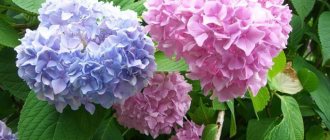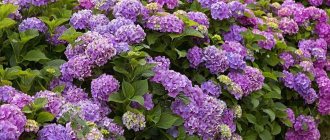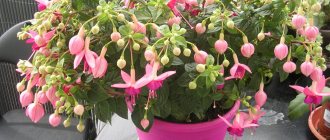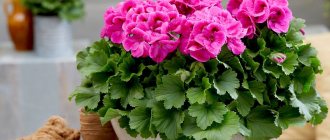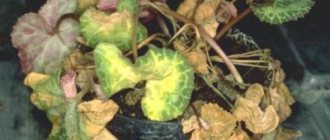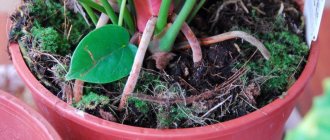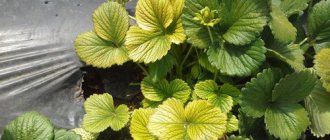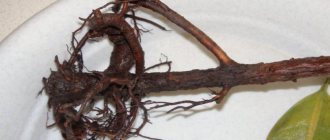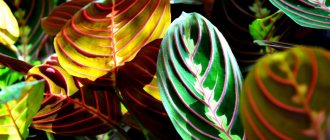Causes of yellowing
If you see that the hydrangea has begun to turn yellow, then the first thing that comes to mind is that somewhere an error in care has crept in or the plant is missing something. Therefore, first of all, you need to evaluate the correctness of care, and only then look for other reasons why a yellow leaf appeared on the plant.
Hydrangea leaves turn yellow due to the following mistakes made when caring for it:
- you flooded the flower. Home hydrangea is a very moisture-loving plant. But even it can be flooded if you water it too often. The first to react to waterlogging will be the leaves, which will begin to turn yellow and fall off;
- lack of warmth. This indoor flower does not like drafts and low temperatures. When a plant finds itself in such a situation, the first signal about unsuitable conditions will be the appearance of a yellow leaf;
- lack of nutrients. Even indoor hydrangea, which grows in a pot, must be ensured that it receives the optimal set of micro- and macroelements;
- lack of sunlight. For normal growth and development of a flower, a certain light regime must be observed. It is important both for the health of hydrangeas and for beautiful flowering. But remember that the light should be diffused, not direct. Otherwise, those with sunburn will be added to the yellow leaves. It manifests itself in the fact that the leaves turn brown and dry out;
- feeding during flowering and formation of stems. If this is not done, after a while the first yellow leaf will appear on the stem.
It is worth looking at the lack of nutrients in more detail. During the flowering period, the plant requires the maximum amount of nutrients. And even a slight lack of them can lead to defective formation of inflorescences, and also cause the leaves to turn yellow. This usually indicates that the soil is deficient in iron and nitrogen.
If caring for the flower turned out to be correct, but the leaf is still yellow, you need to look for another reason. Sometimes hydrangea leaves turn yellow and dry out due to disease. Despite the sufficient resistance of hydrangea to various types of infections, in certain situations it can be attacked by viruses and fungi. Why such situations occur can be answered quite easily. The whole reason here lies, again, in improper care of the flower.
Indoor hydrangeas are not characterized by many diseases, and only some of them can cause yellow leaves to appear. For example, the most common reason why leaves turn yellow is a viral disease such as ring spot. In this case, the sheet not only turns yellow, but also becomes deformed. It is by the deformation of the leaf blade that one can determine that the cause is a virus.
In addition to ring spot, house hydrangea can be affected by axochytic spot. Here the castings also turn yellow. But they also dry out quite quickly, die and fall off. Indoor hydrangea is also characterized by an ailment such as chlorosis. The reason for its occurrence is a violation of the plant’s watering technique. A flower can contract chlorosis after being watered with harsh tap water, which contained a high percentage of lime.
As a result of the accumulation of lime in the soil, it leads to alkalization of the soil. The infected leaf will turn yellow and dry out. They dry out due to the fact that the plant does not have the opportunity to fully feed. Such a situation can lead to the complete death of the flower. As you can see, there are quite a few reasons that can lead to the leaves of a hydrangea turning yellow. But often the reason lies in improper care. Therefore, you need to be very attentive to this indoor flower and caring for it.
What to do if hydrangea has yellow leaves
As soon as the shoots on the bush begin to wither, it is necessary to quickly determine the cause of this and begin to take active action. It is important to remember that the sooner measures are taken, the greater the chance of maintaining the health of the hydrangea.
If the leaves turn yellow, then the following approaches are used:
- if there is a lack of moisture, increase the frequency of watering;
- if there is excess liquid, stop adding water for a while;
- for diseases - treatment with special chemicals;
- if the soil acidity is insufficient, apply special fertilizers;
- if pests are detected, use insecticides.
If the leaves begin to turn yellow due to damage to the roots caused by improper agricultural practices, the hydrangea must be replanted. In this case, damaged areas of the root system are removed. In the planting pits, the drainage layer is increased and additional acidic fertilizers are added.
How to cure diseased leaves
When the leaves turn yellow, it is necessary to urgently take measures to treat the hydrangea, otherwise the flower may die. First of all, you need to find out the cause and then proceed from it in choosing a treatment method.
Let's look at some of them:
- in case of waterlogging, the water regime should be normalized by reducing the number of waterings;
- if there is a lack of heat, move the flower out of the way of drafts and into a more heated room;
- If the cause is identified as a lack of nutrients, start fertilizing. Typically, fertilizers are added to the pot during watering along with water. You should also use only soft water that has settled well.
It is also worth noting that if there is a lack of iron in the soil, then it is necessary to restore the acidity of the soil. To do this, you need to add a solution of vinegar essence to the soil. It is prepared by adding 1 tsp to 10 liters of water. essences. Please note that you can use oxalic or citric acid instead of vinegar. In addition, a special ferovit solution can be used to restore soil pH.
But in a situation where resuming proper care no longer gives the desired result, the flower will have diseases of a viral or fungal nature. Although proper care will help improve the condition of the plant, it will not be enough. Here the infected leaf must be removed, and the hydrangea itself must be treated with special fungicidal preparations. Very often, Bordeaux mixture (1% solution) is used to combat diseases.
Measures to combat chlorosis include replanting the flower in a new pot. Its further watering is carried out only with softened water.
Diseases as a risk factor
Why else the leaves may turn yellow will be indicated by the list of diseases to which paniculate hydrangea is susceptible.
Among them it should be noted:
- ascochyta spotting, which causes early death of foliage;
- ring spot (affects young leaves in the form of light spots, sometimes with subsequent deformation);
- powdery mildew (appears in the form of spots with a grayish coating on the back side of the leaf blade, and on the front side with a yellow-green tint).
In pest control, a one percent solution of Bordeaux mixture comes to the rescue.
Fungicides actively fight diseases. Alirin and Fitosporin can help. In case of a deep form of the disease, you will have to purchase Thiovit, Topaz or Skor. If the leaves of a paniculata hydrangea suddenly turn yellow in your garden plot, everyone who has read this article will know what to do. Having understood the reasons, knowing the source of the problem, you can easily and quickly navigate the situation and make a decision. Let the lush green foliage be restored quickly on the hydrangea, and let the question “why did this happen” arise as rarely as possible.
Disease prevention
Prevention has always and everywhere been the best way to combat various diseases and pathologies. This applies not only to the animal world, but also to the plant world. Therefore, if you want to prevent yellow leaves from appearing on your hydrangea, follow these recommendations:
- Maintain optimal water regime. Do not over-water or dry out the plant;
- water only with soft, settled water;
- place the flower only in a warm room without drafts;
- Avoid direct exposure of the leaves to sunlight;
- do periodic feeding (especially during the flowering period).
You can also sometimes treat the flower with agents against germs and viruses. By following these recommendations, you can prevent the appearance of yellow leaves in indoor hydrangea and preserve its beauty for many years.
Insects attacking a plant
Diseases in hydrangea often appear precisely because of pests that carry viruses from other plants or simply infect the bush.
Leaf aphid
Leaf aphid
An aphid is a very tiny insect that moves with the help of 3 pairs of long legs. It is dangerous because it sucks the juices out of the crop, and also produces sugary discharge after it. Sooty fungus then develops on these secretions and also attracts ants. As a result, the crop grows slowly. If there are a lot of aphids, the foliage becomes yellow and deformed. If there are few aphids, you can wash them off the plant by watering them with a hose or washing the crop with soap and water. Ladybugs also eat aphids. Therefore, if you plant marigolds near the hydrangea, it will attract ladybugs.
If there are a large number of aphids, only spraying with Fitoverm and Akarin will help.
Spider mite
These are tiny pests ranging in size from 0.2 mm to 1 mm. They can be detected by small cobwebs and yellowish spots on the foliage that grow and merge. Ticks like heat and low air humidity, and they actively reproduce. As a result, the foliage dries out. And the plant begins to shed its leaves.
Spider mite
If there are not very many mites, you can wash the plants with a solution of soap. If there are a lot of parasites, then it is worth treating the plants with such means as: Fitoverm, Molniya, Akarin. When using the drug Molniya (third class of danger for humans), 3-4 ml of the product should first be diluted in 2 liters of water. Then add another 8 liters of water.
Akarin is safe for humans and warm-blooded animals. To treat hydrangeas, use a sprayer with a fine spray. Since the product does not penetrate the foliage, it is recommended to add soap for better adhesion. To destroy ticks, it is enough to pour 3 ml into 1 liter of water, and to eliminate aphids - 6 ml into 1 liter of clean water. Parasites begin to die on the 3rd day after treatment, and the maximum number of pests die after 6 days.
For spider mites and aphids, you can spray the bushes with the biological product Bicol, which is safe, that is, it can only harm parasites. To create a working solution, dissolve 60-160 g in a bucket of water (10 l).
Root nematode
These are tiny worms and love high soil moisture. Their activity can be noticed by the appearance of growths - galls on stems and roots. These nematodes work their way through the roots to the stems and foliage, leaving a toxic secretion. In this case, the plants stop growing and may die.
Root nematode
Professional gardeners advise tearing out and burning a plant that has been attacked by nematodes. True, you can also spray the bushes with Karbofos. But the product against direct sunlight quickly disintegrates and loses its effect. It is recommended to spray the product in early spring, even before the plants bloom, as it destroys bees. Make a working solution by adding 75 g to a bucket of water (10 l). The seedlings are sprayed on a warm sunny day, when there is no wind and the air temperature has reached +15 degrees Celsius.
Slug
Slug
If plantings are too thick, slugs can breed in them. They actively eat foliage. Slugs can be collected by hand. You can also scatter Moluscicide granules on the ground.

